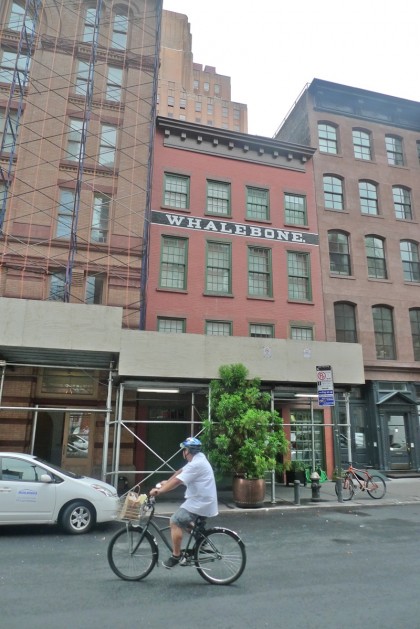Categories
Left column house ads
Nosy Neighbor: Why Does 161 Duane Say ‘Whalebone’?
September 21, 2012 History, Real Estate
 Why does the building on Duane (just east of Hudson) say “Whalebone”? —A.
Why does the building on Duane (just east of Hudson) say “Whalebone”? —A.
The building says “Whalebone” because 161 Duane used to be the site of a “whalebone cutter”: George Messman, who was the last whalebone cutter in the U.S.A., according to a June 6 1920 article (PDF) in the New York Times. Messman worked there for 56 years, with two predecessors (A.J. Vetter and, before him, William Forster) predating him in the same building.
“The quaint brick building at 161 Duane Street, which has housed the whalebone-cutting business with never a break since the year 1860, was originally built as a private house. Then it was used as a schoolhouse, and later descended to a trade level, being used for a coffee mill. […] In 1860 the building was taken over for the then flourishing whalebone business, which, with successive years, has been pushed up, until recently it has occupied only the two upper stories, reached by almost perpendicular old stairs. Over the street entrance to the building hangs a plain sign with the word ‘Whalebone’ in large white letters on a black ground. This sign is old, but new in comparison with the one that is nailed up over it, which displayed the name of A.J. Vetter until time obliterated it and the old rough board above that which at one time told the world that William Forster was in the whalebone business.”
There’s more in the article about whalebone, which was used in hoop skirts, ladies’ undergarments (hence “boning” in corsets), umbrellas, felt hats (for structure), bullet probes (during wartime), and whips. Metal took its place for many uses; whips became unnecessary in the age of the automobile.
Downtown Express, meanwhile, ran an article in 2007 about architect Joseph Pell Lombardi’s development of 161 Duane, combining it with 159 Duane—the Bouley flagship’s current home—to form the Mohawk Atelier. (The Mohawk Electric Company was at 159 Duane.) “Lombardi was always determined to bring back the Whalebone sign, which had lingered on the building’s brickwork underneath the white paint.” The article also notes that “Under the whalebone shop in the 1890s, the building housed Ye Olde Tavern”—a far cry, no doubt, from Bouley’s gleaming kitchen.
Got a question? Email it to tribecacitizen@gmail.com.
Previous Nosy Neighbor posts:
• What’s the story behind those Harrison townhouses?
• What are those white things at 137 Franklin?
• What’s that thing at W. Broadway and Leonard?
• What happens to old cobblestones?
• Are buses allowed to idle on Laight?
• What’s happening with the Verizon building?
• Will the construction at Hudson and Laight ever end?
• What is Esoteric on Walker Street?
• What’s up with the building under renovation on Franklin?
• Is N. Moore getting cobblestoned?
• What are those orange awnings for?
• What’s happening at 73 Warren?
• Can you recommend any Tribeca picture books?
• Why are those shuttles on Greenwich?
• What’s coming to 15 Canal Street?
• Who enforces sidewalk-café regulations?
• What’s going on at 27 Desbrosses?
• What happened to the Lilac?
• When will those trailers on West Street go away?
• Do you know anything about 20-24 Varick?
• What’s happening to my parking lot?
• Is Pier 26 being worked on again?
• What’s up with Jin Market?
• What are those black pellets on Pier 25?
• What do the characters on 47 Vestry mean?
• When is T.J. Maxx opening?
• Where is the Special Forces monument going?
• Who’s moving into 151 Hudson?
• What’s going on at 172 Duane?
• Where is Compose’s pastry chef cooking now?
• What’s up with those Verizon carts?
• Where was the original Blues Bar?
• Who are the guys in the geeky pants?
• Why are the windows above Ponte’s boarded up?
• Can we walk on the West Street medians?
• What’s going on in 157 Hudson?
• What’s the new painting at 153 Hudson?
• What’s up with 55 Warren/55 Murray?
• What is this P.C. Richard & Son Theater I keep hearing about?
• What’s the story behind the lights at 289 Church?
• What’s the Dream House at 275 Church?
• How come every every film and TV shoot seems to have a trailer with doors marked “Lucy” and “Desi”?
1 Comment
Subscribe
Subscribe to the TC Newsletter













FYI: Whalebone wasn’t really bone (not that you claimed it was, which you didn’t). It was strips of baleen, the material baleen whales have in their mouths to filter krill and plankton from seawater.